valve JEEP PATRIOT 2008 1.G Owners Manual
[x] Cancel search | Manufacturer: JEEP, Model Year: 2008, Model line: PATRIOT, Model: JEEP PATRIOT 2008 1.GPages: 438, PDF Size: 6.71 MB
Page 254 of 438
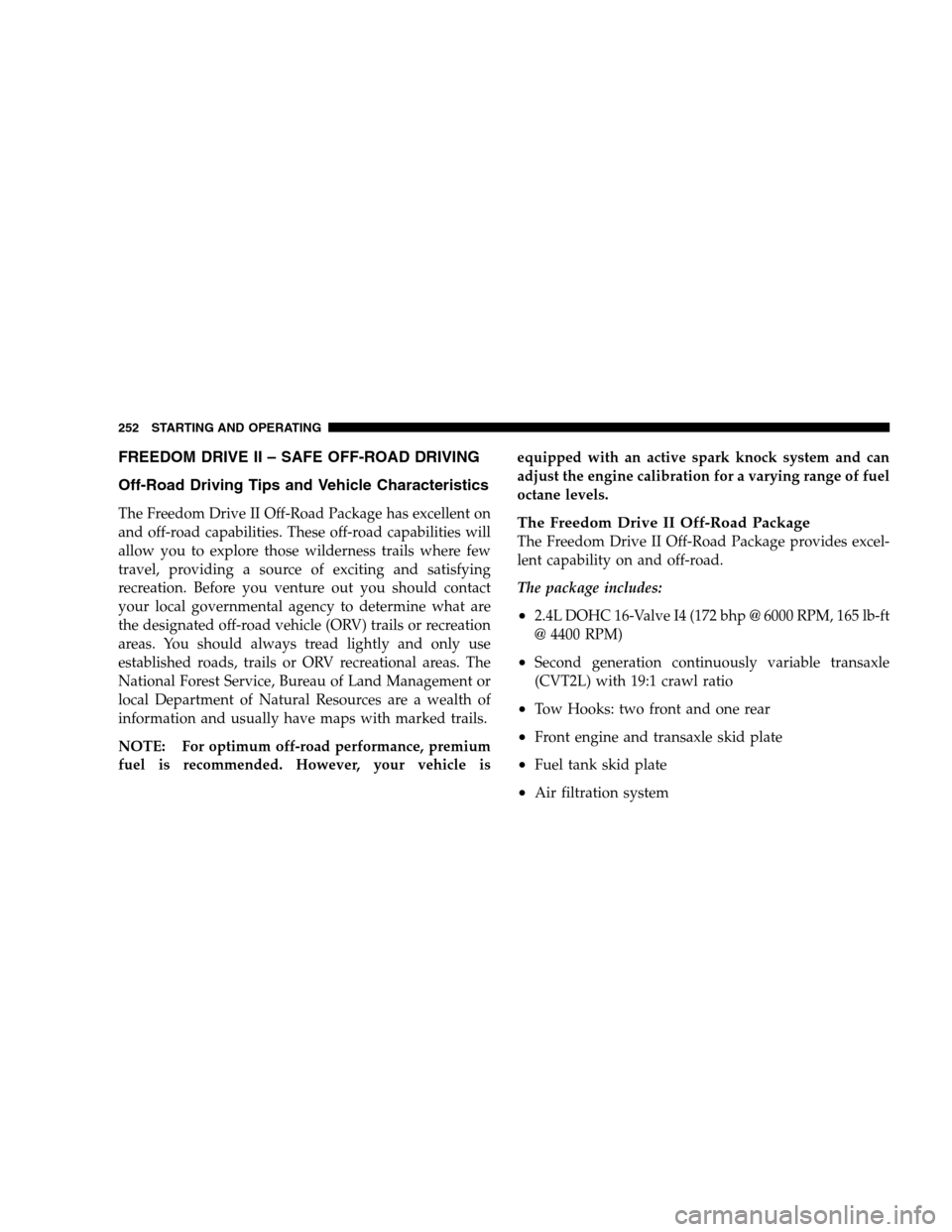
FREEDOM DRIVE II – SAFE OFF-ROAD DRIVING
Off-Road Driving Tips and Vehicle Characteristics
The Freedom Drive II Off-Road Package has excellent on
and off-road capabilities. These off-road capabilities will
allow you to explore those wilderness trails where few
travel, providing a source of exciting and satisfying
recreation. Before you venture out you should contact
your local governmental agency to determine what are
the designated off-road vehicle (ORV) trails or recreation
areas. You should always tread lightly and only use
established roads, trails or ORV recreational areas. The
National Forest Service, Bureau of Land Management or
local Department of Natural Resources are a wealth of
information and usually have maps with marked trails.
NOTE: For optimum off-road performance, premium
fuel is recommended. However, your vehicle isequipped with an active spark knock system and can
adjust the engine calibration for a varying range of fuel
octane levels.The Freedom Drive II Off-Road Package
The Freedom Drive II Off-Road Package provides excel-
lent capability on and off-road.
The package includes:
•2.4L DOHC 16-Valve I4 (172 bhp @ 6000 RPM, 165 lb-ft
@ 4400 RPM)
•Second generation continuously variable transaxle
(CVT2L) with 19:1 crawl ratio
•Tow Hooks: two front and one rear
•Front engine and transaxle skid plate
•Fuel tank skid plate
•Air filtration system
252 STARTING AND OPERATING
Page 283 of 438
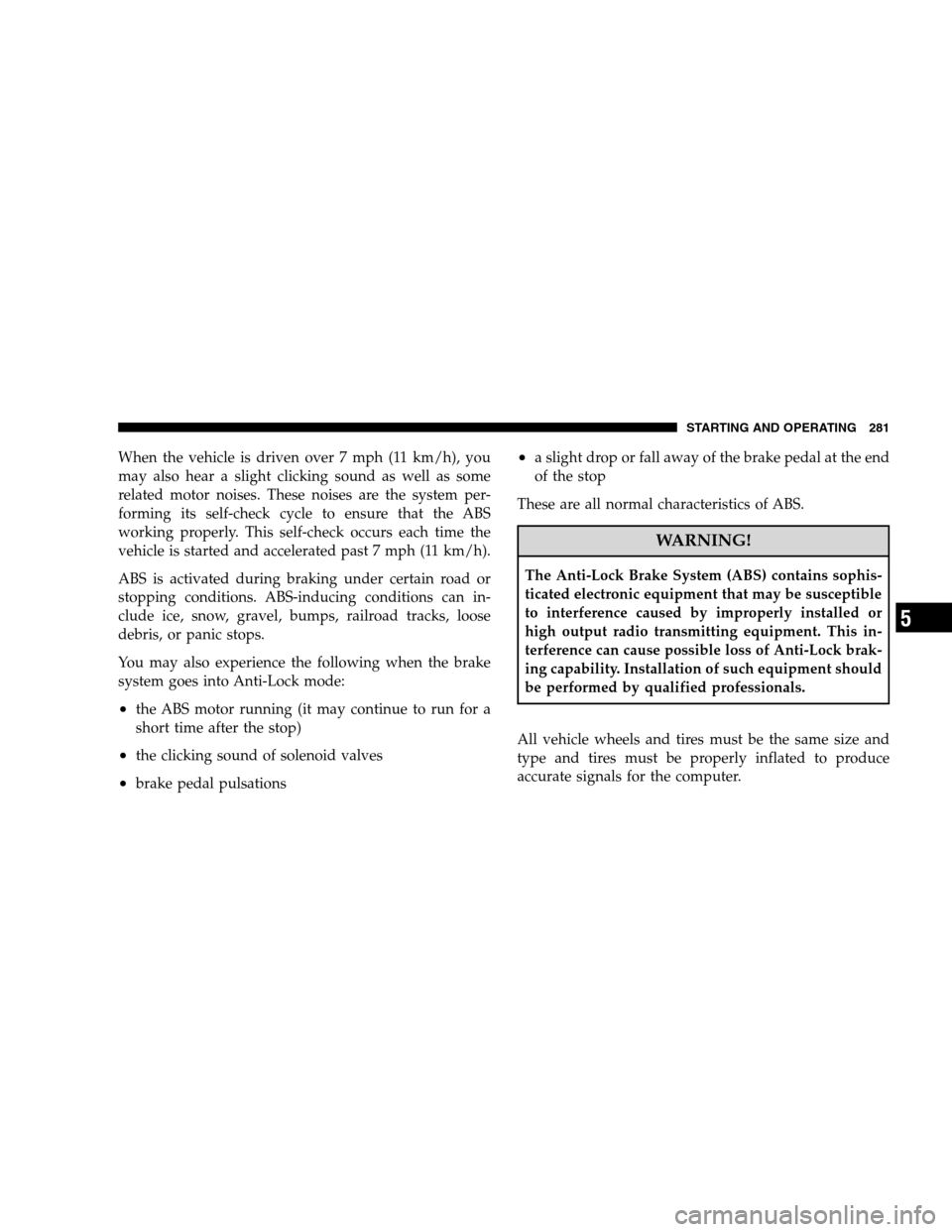
When the vehicle is driven over 7 mph (11 km/h), you
may also hear a slight clicking sound as well as some
related motor noises. These noises are the system per-
forming its self-check cycle to ensure that the ABS
working properly. This self-check occurs each time the
vehicle is started and accelerated past 7 mph (11 km/h).
ABS is activated during braking under certain road or
stopping conditions. ABS-inducing conditions can in-
clude ice, snow, gravel, bumps, railroad tracks, loose
debris, or panic stops.
You may also experience the following when the brake
system goes into Anti-Lock mode:
•the ABS motor running (it may continue to run for a
short time after the stop)
•the clicking sound of solenoid valves
•brake pedal pulsations
•a slight drop or fall away of the brake pedal at the end
of the stop
These are all normal characteristics of ABS.
WARNING!
The Anti-Lock Brake System (ABS) contains sophis-
ticated electronic equipment that may be susceptible
to interference caused by improperly installed or
high output radio transmitting equipment. This in-
terference can cause possible loss of Anti-Lock brak-
ing capability. Installation of such equipment should
be performed by qualified professionals.
All vehicle wheels and tires must be the same size and
type and tires must be properly inflated to produce
accurate signals for the computer.
STARTING AND OPERATING 281
5
Page 295 of 438
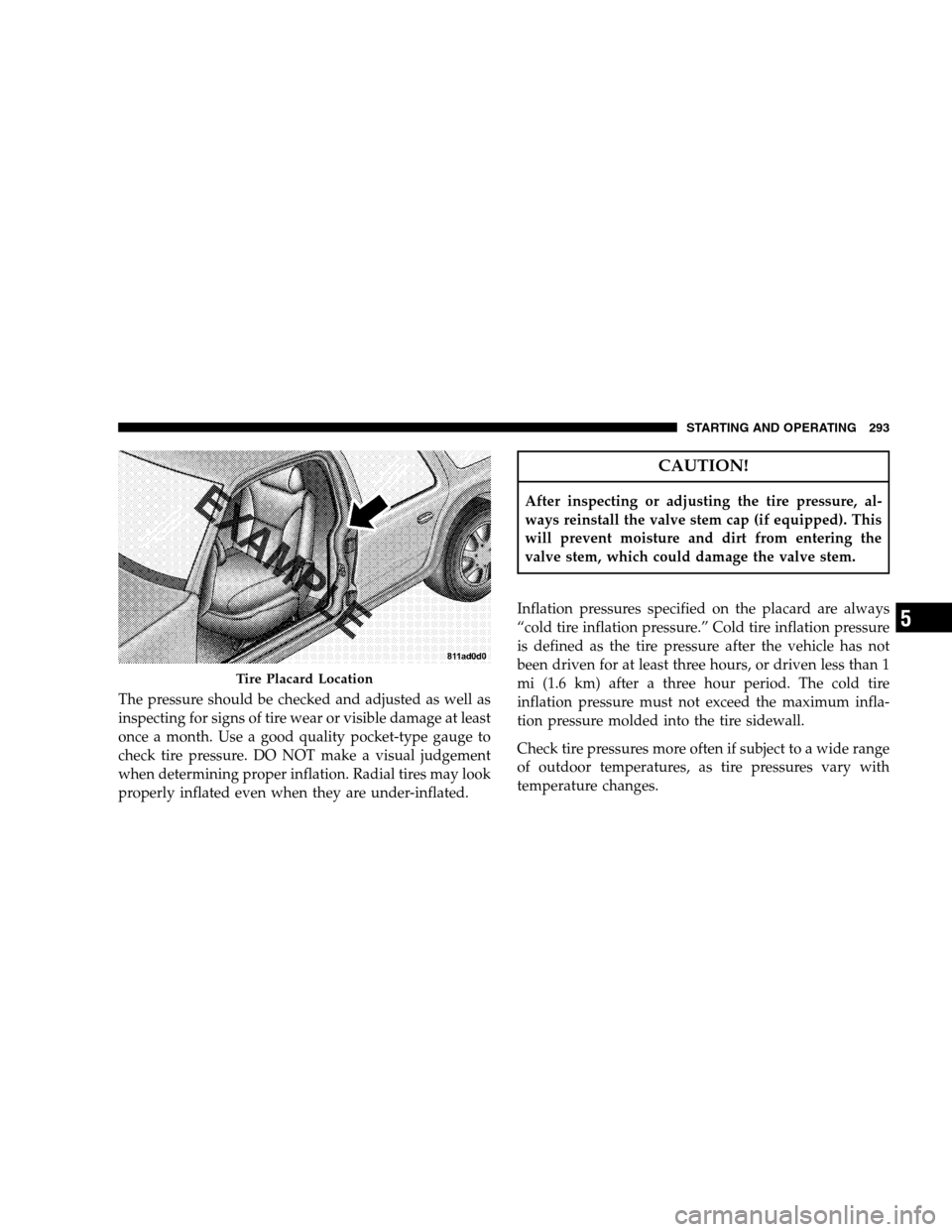
The pressure should be checked and adjusted as well as
inspecting for signs of tire wear or visible damage at least
once a month. Use a good quality pocket-type gauge to
check tire pressure. DO NOT make a visual judgement
when determining proper inflation. Radial tires may look
properly inflated even when they are under-inflated.
CAUTION!
After inspecting or adjusting the tire pressure, al-
ways reinstall the valve stem cap (if equipped). This
will prevent moisture and dirt from entering the
valve stem, which could damage the valve stem.
Inflation pressures specified on the placard are always
“cold tire inflation pressure.” Cold tire inflation pressure
is defined as the tire pressure after the vehicle has not
been driven for at least three hours, or driven less than 1
mi (1.6 km) after a three hour period. The cold tire
inflation pressure must not exceed the maximum infla-
tion pressure molded into the tire sidewall.
Check tire pressures more often if subject to a wide range
of outdoor temperatures, as tire pressures vary with
temperature changes.
Tire Placard Location
STARTING AND OPERATING 293
5
Page 305 of 438
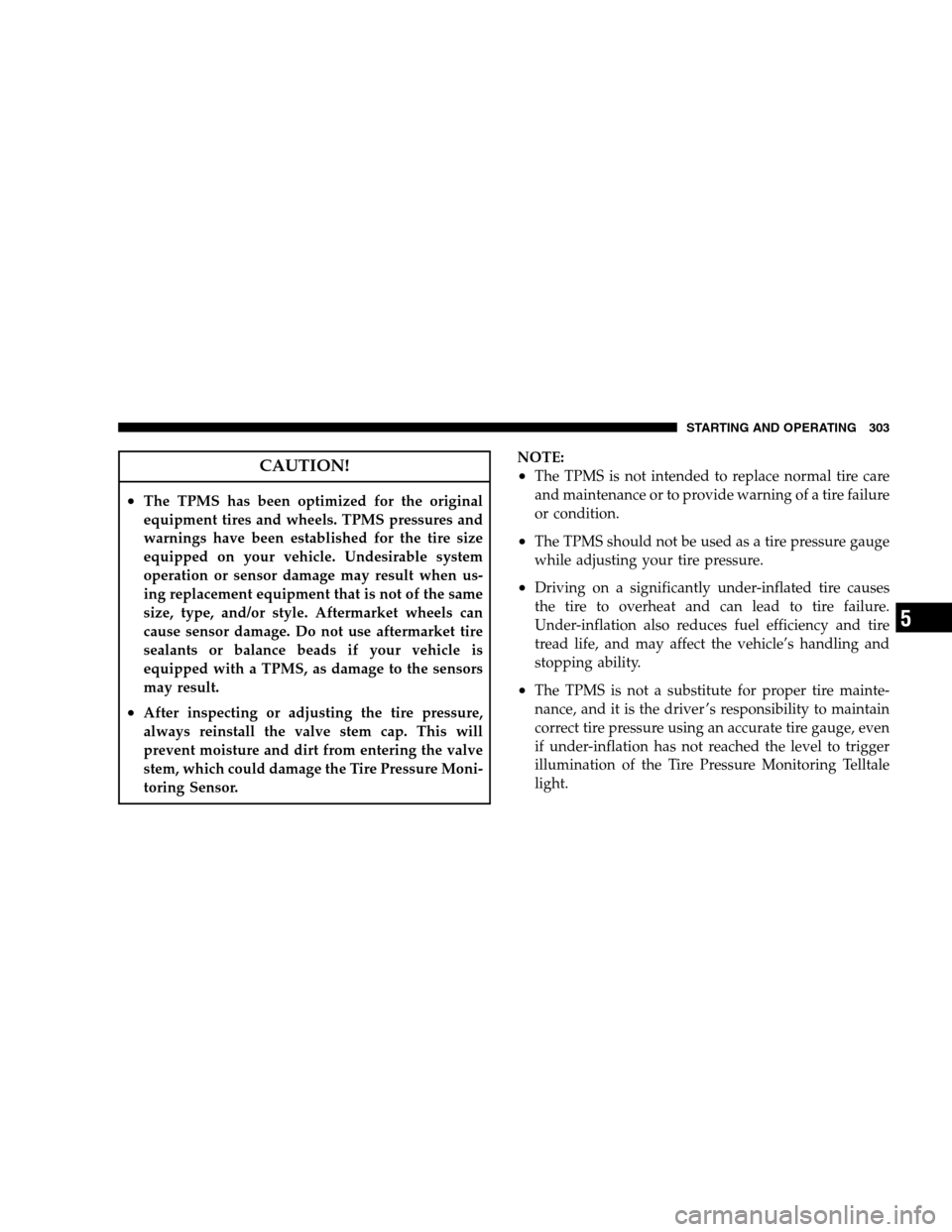
CAUTION!
•The TPMS has been optimized for the original
equipment tires and wheels. TPMS pressures and
warnings have been established for the tire size
equipped on your vehicle. Undesirable system
operation or sensor damage may result when us-
ing replacement equipment that is not of the same
size, type, and/or style. Aftermarket wheels can
cause sensor damage. Do not use aftermarket tire
sealants or balance beads if your vehicle is
equipped with a TPMS, as damage to the sensors
may result.
•After inspecting or adjusting the tire pressure,
always reinstall the valve stem cap. This will
prevent moisture and dirt from entering the valve
stem, which could damage the Tire Pressure Moni-
toring Sensor.NOTE:
•The TPMS is not intended to replace normal tire care
and maintenance or to provide warning of a tire failure
or condition.
•The TPMS should not be used as a tire pressure gauge
while adjusting your tire pressure.
•Driving on a significantly under-inflated tire causes
the tire to overheat and can lead to tire failure.
Under-inflation also reduces fuel efficiency and tire
tread life, and may affect the vehicle’s handling and
stopping ability.
•The TPMS is not a substitute for proper tire mainte-
nance, and it is the driver ’s responsibility to maintain
correct tire pressure using an accurate tire gauge, even
if under-inflation has not reached the level to trigger
illumination of the Tire Pressure Monitoring Telltale
light.
STARTING AND OPERATING 303
5
Page 306 of 438
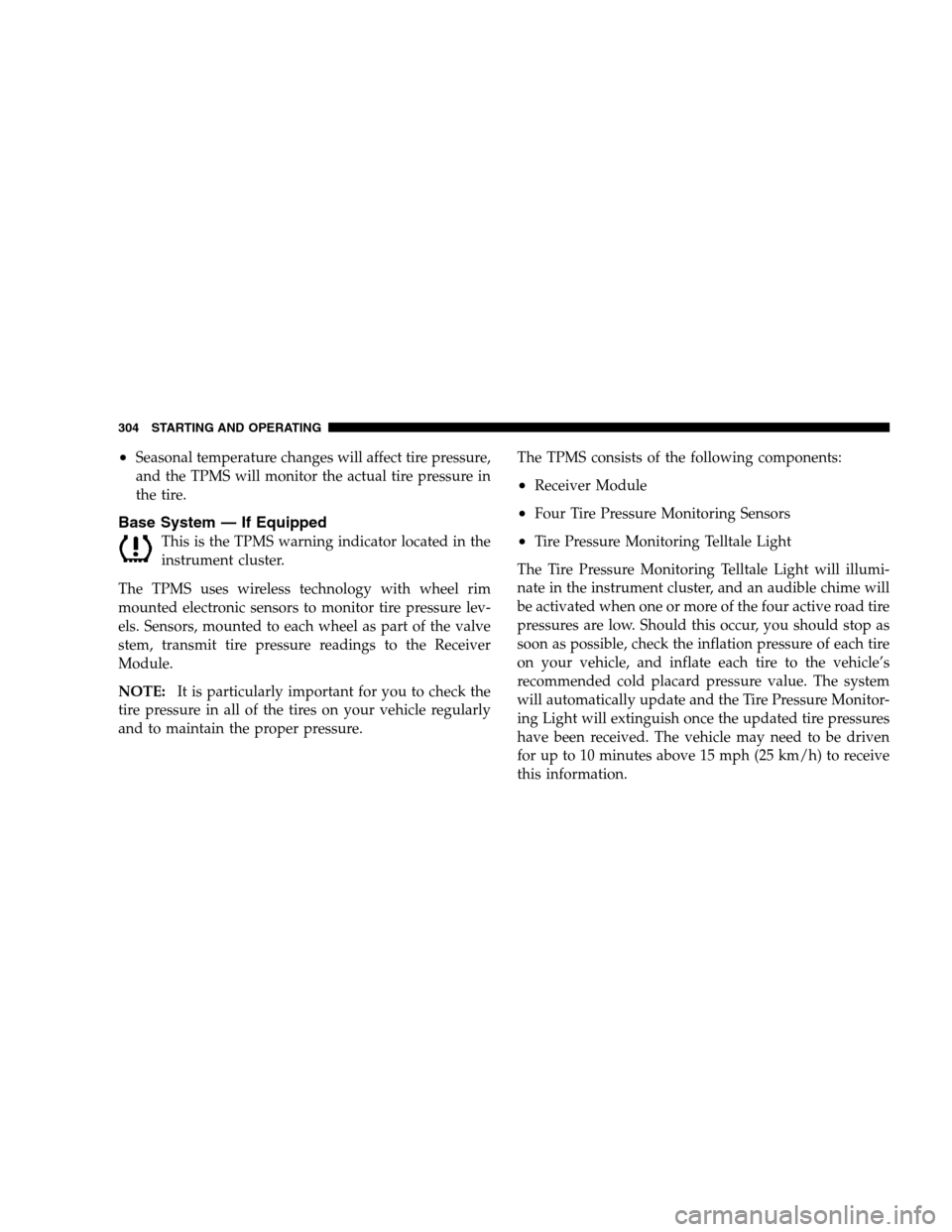
•Seasonal temperature changes will affect tire pressure,
and the TPMS will monitor the actual tire pressure in
the tire.
Base System — If Equipped
This is the TPMS warning indicator located in the
instrument cluster.
The TPMS uses wireless technology with wheel rim
mounted electronic sensors to monitor tire pressure lev-
els. Sensors, mounted to each wheel as part of the valve
stem, transmit tire pressure readings to the Receiver
Module.
NOTE:It is particularly important for you to check the
tire pressure in all of the tires on your vehicle regularly
and to maintain the proper pressure.The TPMS consists of the following components:
•Receiver Module
•Four Tire Pressure Monitoring Sensors
•Tire Pressure Monitoring Telltale Light
The Tire Pressure Monitoring Telltale Light will illumi-
nate in the instrument cluster, and an audible chime will
be activated when one or more of the four active road tire
pressures are low. Should this occur, you should stop as
soon as possible, check the inflation pressure of each tire
on your vehicle, and inflate each tire to the vehicle’s
recommended cold placard pressure value. The system
will automatically update and the Tire Pressure Monitor-
ing Light will extinguish once the updated tire pressures
have been received. The vehicle may need to be driven
for up to 10 minutes above 15 mph (25 km/h) to receive
this information.
304 STARTING AND OPERATING
Page 308 of 438
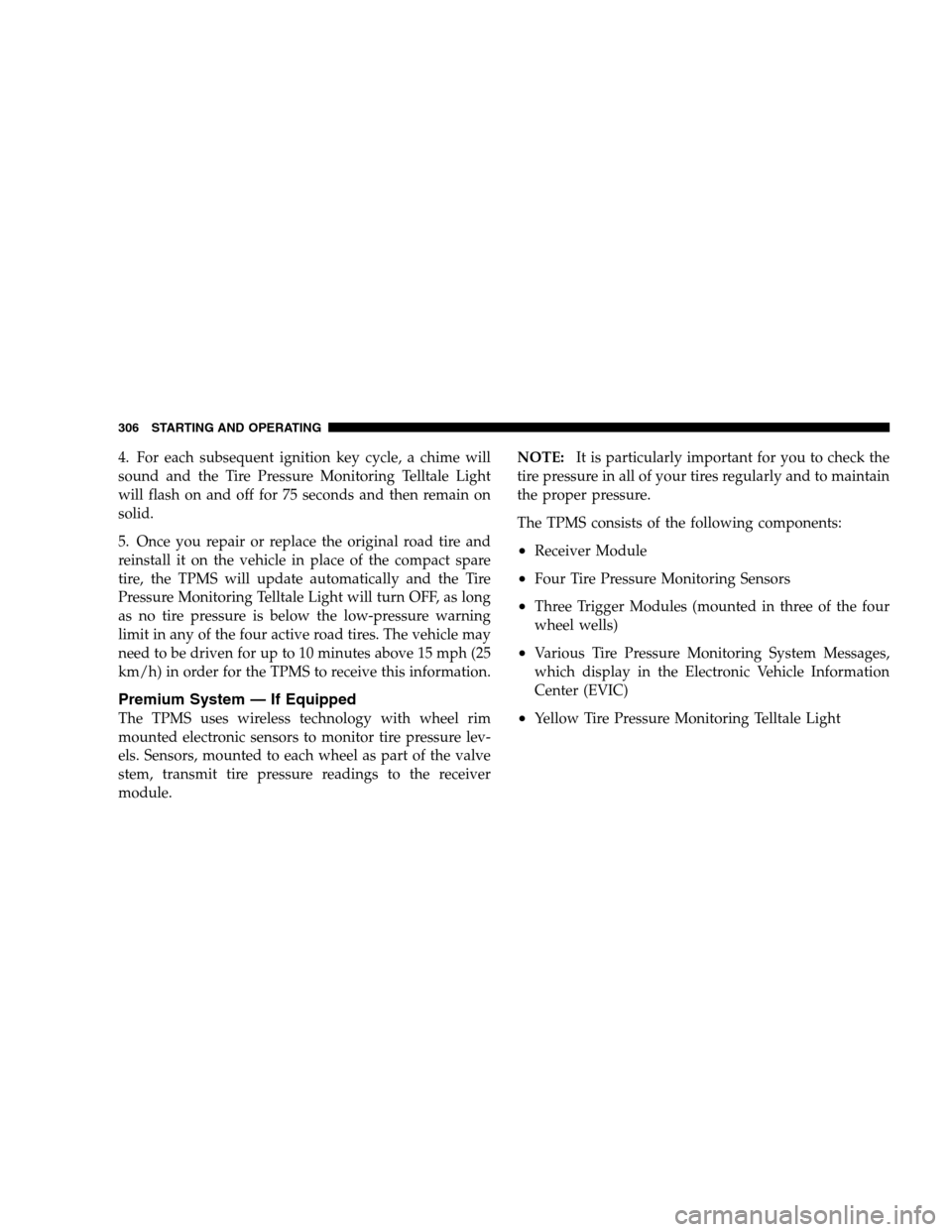
4. For each subsequent ignition key cycle, a chime will
sound and the Tire Pressure Monitoring Telltale Light
will flash on and off for 75 seconds and then remain on
solid.
5. Once you repair or replace the original road tire and
reinstall it on the vehicle in place of the compact spare
tire, the TPMS will update automatically and the Tire
Pressure Monitoring Telltale Light will turn OFF, as long
as no tire pressure is below the low-pressure warning
limit in any of the four active road tires. The vehicle may
need to be driven for up to 10 minutes above 15 mph (25
km/h) in order for the TPMS to receive this information.
Premium System — If Equipped
The TPMS uses wireless technology with wheel rim
mounted electronic sensors to monitor tire pressure lev-
els. Sensors, mounted to each wheel as part of the valve
stem, transmit tire pressure readings to the receiver
module.NOTE:It is particularly important for you to check the
tire pressure in all of your tires regularly and to maintain
the proper pressure.
The TPMS consists of the following components:
•Receiver Module
•Four Tire Pressure Monitoring Sensors
•Three Trigger Modules (mounted in three of the four
wheel wells)
•Various Tire Pressure Monitoring System Messages,
which display in the Electronic Vehicle Information
Center (EVIC)
•Yellow Tire Pressure Monitoring Telltale Light
306 STARTING AND OPERATING
Page 338 of 438
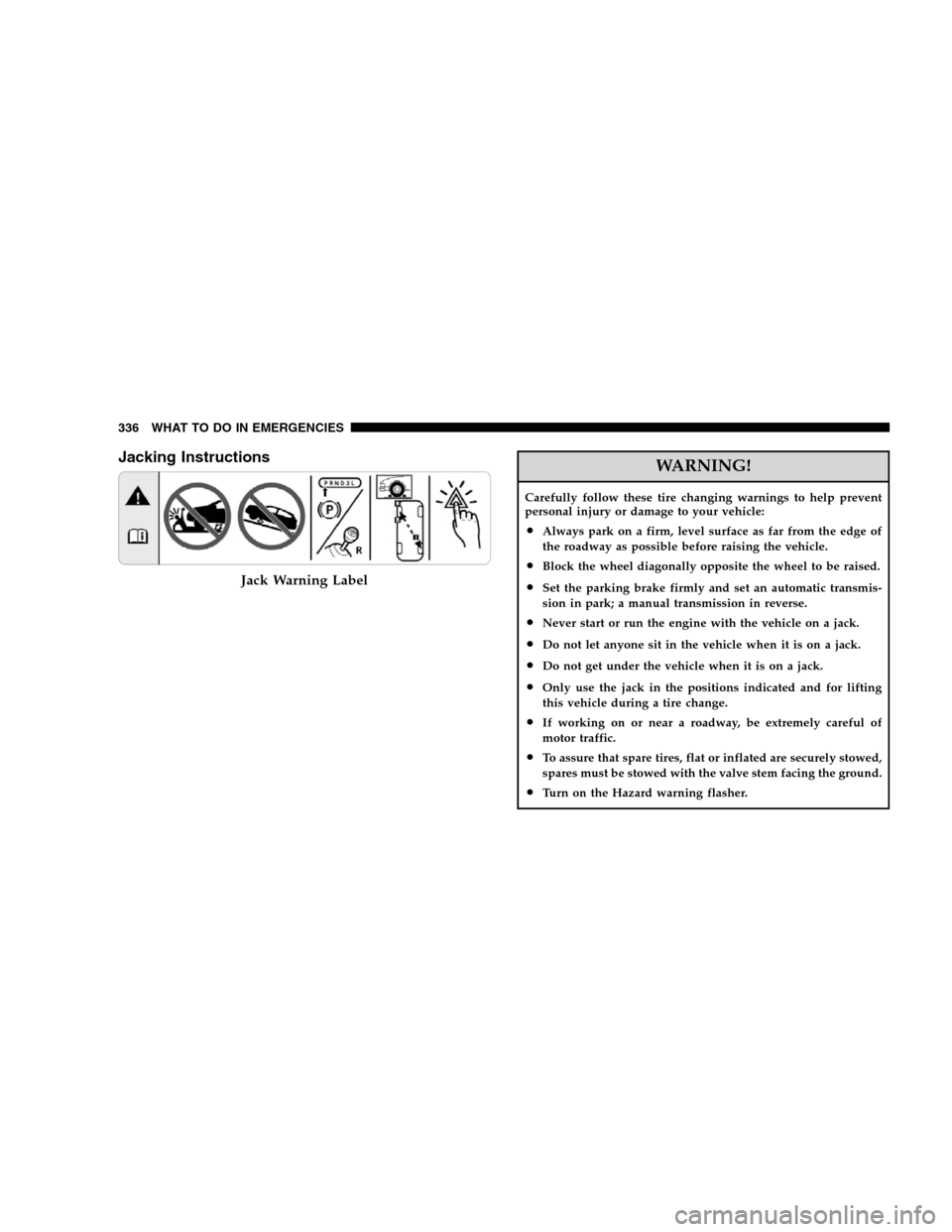
Jacking InstructionsWARNING!
Carefully follow these tire changing warnings to help prevent
personal injury or damage to your vehicle:
•Always park on a firm, level surface as far from the edge of
the roadway as possible before raising the vehicle.
•Block the wheel diagonally opposite the wheel to be raised.
•Set the parking brake firmly and set an automatic transmis-
sion in park; a manual transmission in reverse.
•Never start or run the engine with the vehicle on a jack.
•Do not let anyone sit in the vehicle when it is on a jack.
•Do not get under the vehicle when it is on a jack.
•Only use the jack in the positions indicated and for lifting
this vehicle during a tire change.
•If working on or near a roadway, be extremely careful of
motor traffic.
•To assure that spare tires, flat or inflated are securely stowed,
spares must be stowed with the valve stem facing the ground.
•Turn on the Hazard warning flasher.
Jack Warning Label
336 WHAT TO DO IN EMERGENCIES
Page 360 of 438
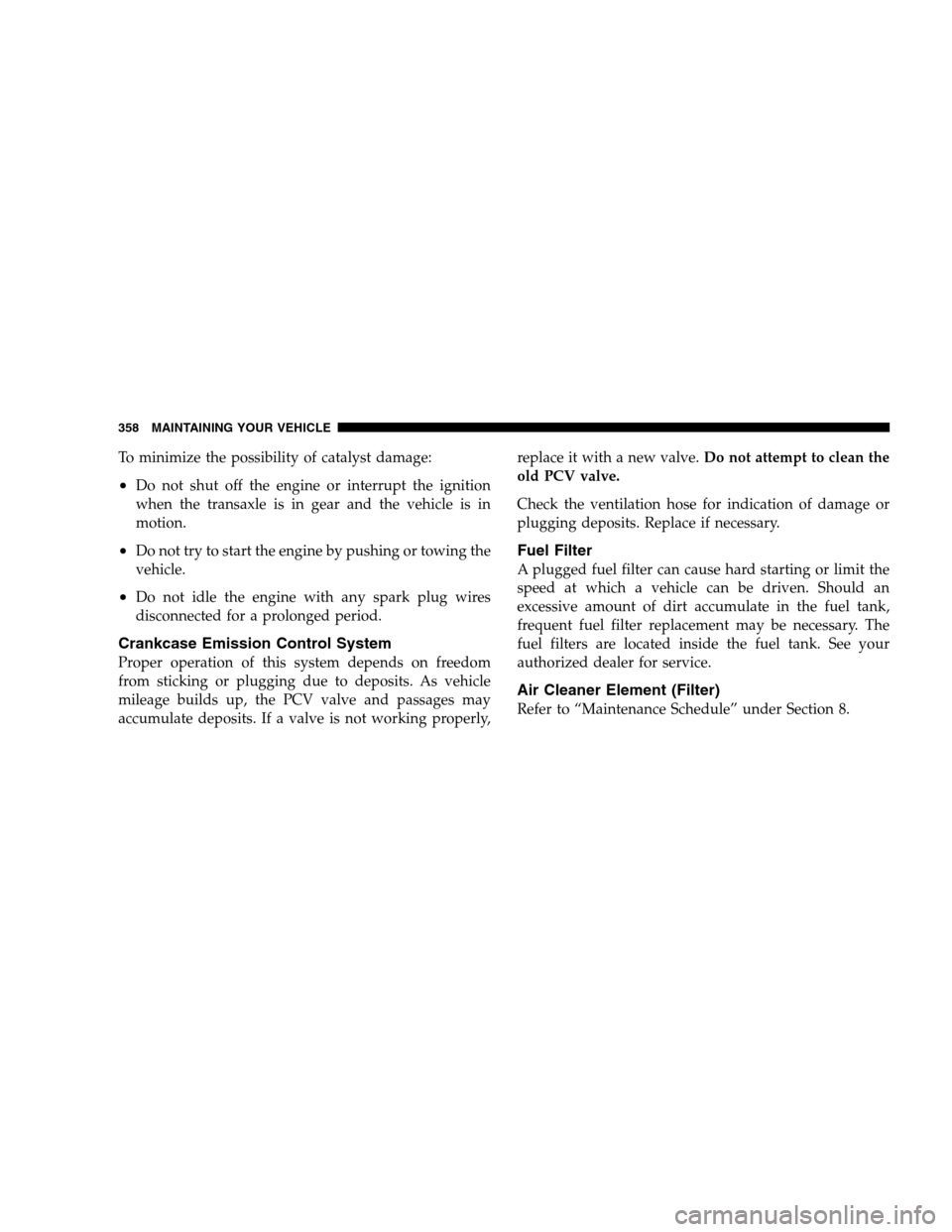
To minimize the possibility of catalyst damage:
•Do not shut off the engine or interrupt the ignition
when the transaxle is in gear and the vehicle is in
motion.
•Do not try to start the engine by pushing or towing the
vehicle.
•Do not idle the engine with any spark plug wires
disconnected for a prolonged period.
Crankcase Emission Control System
Proper operation of this system depends on freedom
from sticking or plugging due to deposits. As vehicle
mileage builds up, the PCV valve and passages may
accumulate deposits. If a valve is not working properly,replace it with a new valve.Do not attempt to clean the
old PCV valve.
Check the ventilation hose for indication of damage or
plugging deposits. Replace if necessary.
Fuel Filter
A plugged fuel filter can cause hard starting or limit the
speed at which a vehicle can be driven. Should an
excessive amount of dirt accumulate in the fuel tank,
frequent fuel filter replacement may be necessary. The
fuel filters are located inside the fuel tank. See your
authorized dealer for service.
Air Cleaner Element (Filter)
Refer to “Maintenance Schedule” under Section 8.
358 MAINTAINING YOUR VEHICLE
Page 386 of 438
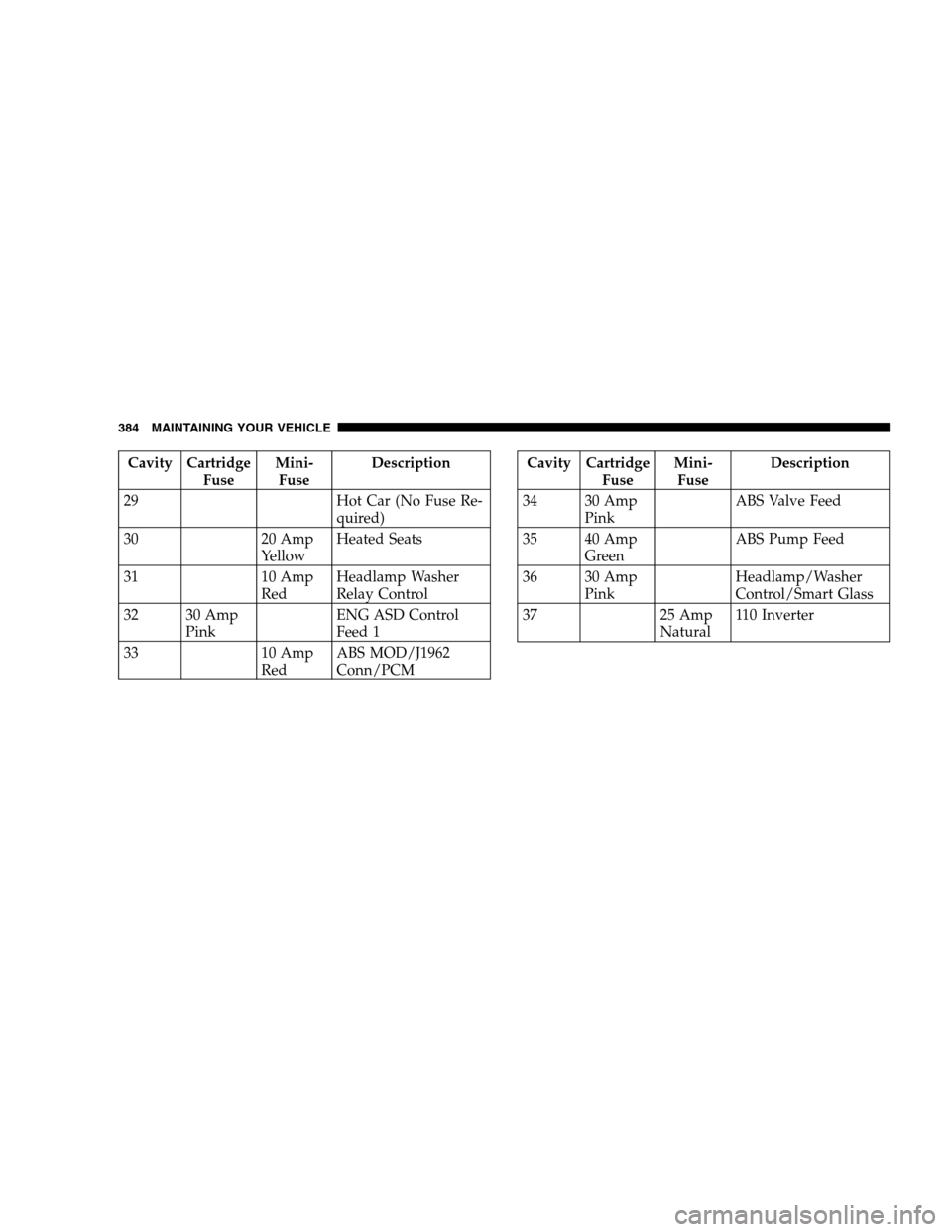
Cavity Cartridge
FuseMini-
FuseDescription
29 Hot Car (No Fuse Re-
quired)
30 20 Amp
YellowHeated Seats
31 10 Amp
RedHeadlamp Washer
Relay Control
32 30 Amp
PinkENG ASD Control
Feed 1
33 10 Amp
RedABS MOD/J1962
Conn/PCMCavity Cartridge
FuseMini-
FuseDescription
34 30 Amp
PinkABS Valve Feed
35 40 Amp
GreenABS Pump Feed
36 30 Amp
PinkHeadlamp/Washer
Control/Smart Glass
37 25 Amp
Natural110 Inverter
384 MAINTAINING YOUR VEHICLE
Page 406 of 438
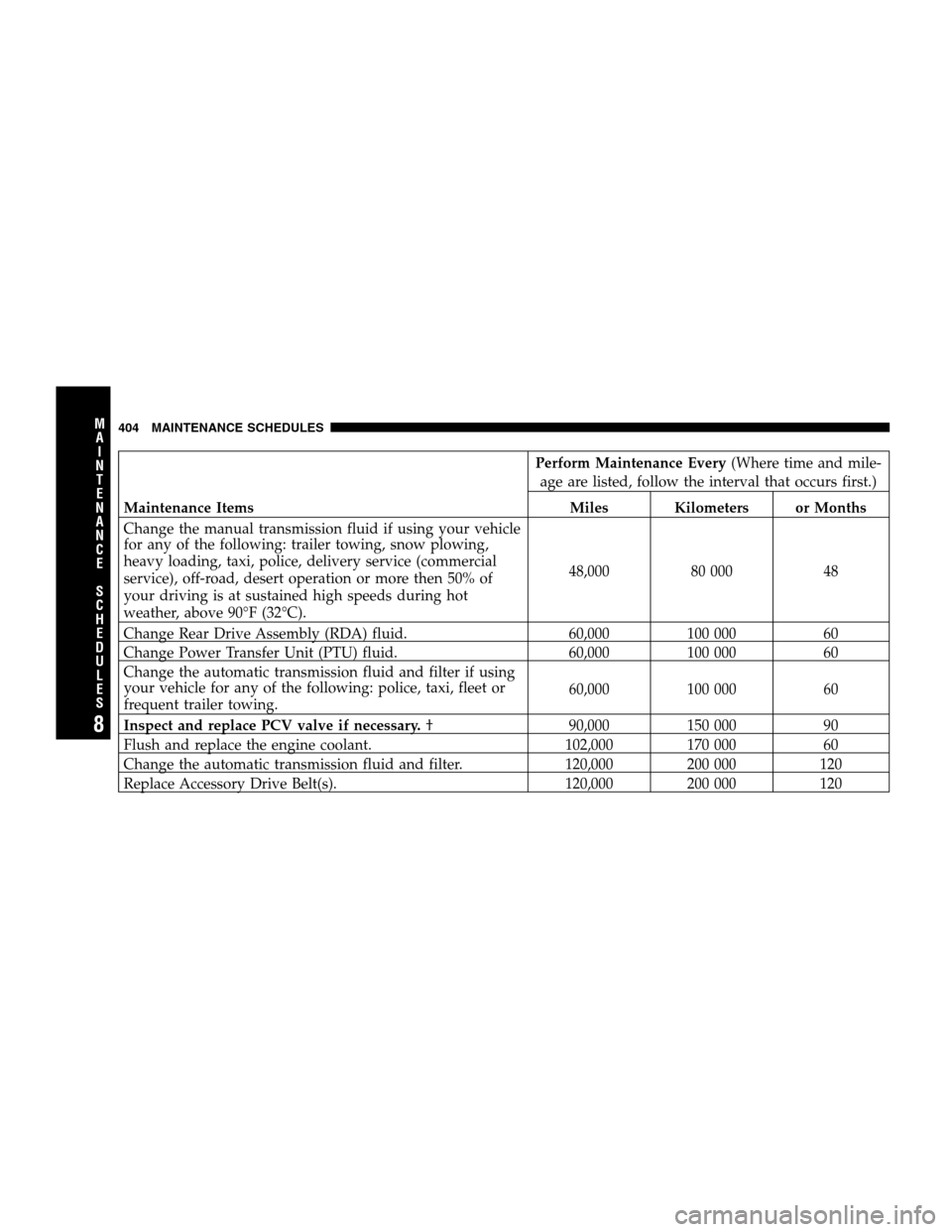
Perform Maintenance Every(Where time and mile-
age are listed, follow the interval that occurs first.)
Maintenance Items Miles Kilometers or Months
Change the manual transmission fluid if using your vehicle
for any of the following: trailer towing, snow plowing,
heavy loading, taxi, police, delivery service (commercial
service), off-road, desert operation or more then 50% of
your driving is at sustained high speeds during hot
weather, above 90°F (32°C).48,000 80 000 48
Change Rear Drive Assembly (RDA) fluid. 60,000 100 000 60
Change Power Transfer Unit (PTU) fluid. 60,000 100 000 60
Change the automatic transmission fluid and filter if using
your vehicle for any of the following: police, taxi, fleet or
frequent trailer towing.60,000 100 000 60
Inspect and replace PCV valve if necessary.† 90,000 150 000 90
Flush and replace the engine coolant. 102,000 170 000 60
Change the automatic transmission fluid and filter. 120,000 200 000 120
Replace Accessory Drive Belt(s). 120,000 200 000 120
404 MAINTENANCE SCHEDULES
8
M
A
I
N
T
E
N
A
N
C
E
S
C
H
E
D
U
L
E
S